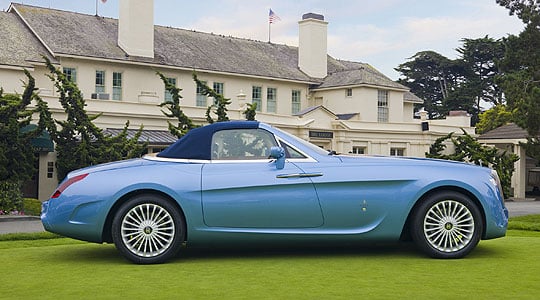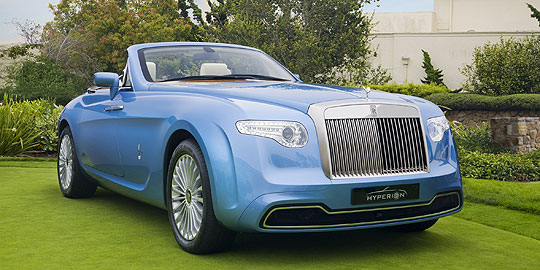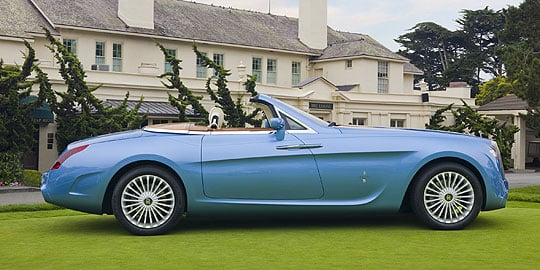
A custom-built two-seater derived from the Rolls-Royce Drophead Coupe, the Hyperion is a remarkable creation in more ways than one. Poignantly, just as it was about to be unveiled to the world at Pebble Beach, Andrea Pininfarina died in a road accident. Hence the Hyperion’s owner has dedicated the car to the late Chairman and CEO of the design house.
The car came about when Roland Hall, owner of a Drophead Coupe, asked Pininfarina to create a custom-built car that would evoke the appeal of the sumptuous automobiles of the 1930s. The result is ‘firmly rooted in the values of the Pininfarina and Rolls-Royce brands’, with lines and dimensions startlingly different from typical 21st Century designs. Even the name, Hyperion (a Titan of Greek mythology), underlines the car’s architectural and figurative power. Those familiar with Pininfarina-styled Rolls-Royces of the past might draw comparisons: the 1951 Silver Dawn saloon, perhaps, or the 1975 Camargue coupe.

Think of the most extravagant cars of the 1930s and the bonnet leaps instantly to mind: it must be majestic and, of course, very long – seeming to ‘surge’ forward. And the body of the car should cocoon the driver and his passengers. In this case, there is only one passenger: Pininfarina moved the driving position further back (400mm) and took out the Drophead Coupe’s rear seats. “We designed a new hood, which folds behind the seats under a wood-lined cover. In front of the windscreen we created two compartments for small items or for sports equipment, such as Mr. Hall’s hunting rifles.”
The Hyperion’s bodywork is of carbonfibre, with doors of solid wood made by craftsmen more used to creating components for luxury boats. Pininfarina’s designers also extended the roof and shortened the rear end, using soft, ‘fluid’ surfaces to balance the volumes of the car. At the front, the classic Rolls-Royce grille has been slightly inclined, while recessed bi-xenon headlights and LED technology are intended to convey ‘sportiness and elegance’. At the rear, the cut-off tail, strongly inclined downwards (with a flat closure borrowed from boat-building), recalls Pininfarina’s legendary sports berlinettas of the 50s and 60s.

The interior is little changed, although one detail stands out. The dashboard clock is a timepiece designed specifically for the Hyperion by Girard-Perregaux, based on the Swiss watchmaker’s Vintage 1945 Tourbillion. Thanks to an ingenious anchorage system, it sits on the dashboard but can readily be removed from its mount and slipped onto its owner’s wrist.
Mr. Roland Hall, commissioning client and owner of the Hyperion, pays his respects to the memory of Andrea Pininfarina when he calls the new creation “a car as extraordinary as the man who left us, but who will remain with us forever”.
Text: Charis Whitcombe
Photos: Pininfarina
ClassicInside - The Classic Driver Newsletter
Free Subscription!



